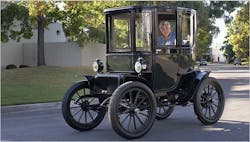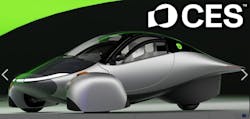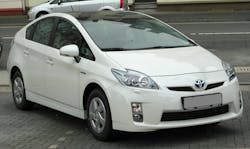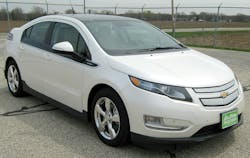All-Electric Vehicles Prepare To Shock The Automotive Market
The future was here a hundred years ago. Too many people think electric vehicles are new and unique and the natural progression from hybrids. What many people overlook is that cars like the Baker Electric (Fig. 1) were quite popular in the early 1900s. The top speed was about 22 mph. Jay Leno, host of The Tonight Show, owns one that is still operational.
There were even early hybrids before gas engines and cheap gasoline pushed out the electrics. Yet early electric cars, batteries, and chargers were quite advanced. The land speed record was held at one time by Walter Baker’s electric Torpedo. It hit 75 mph in 1902. It was also the first car to have seat belts.
Edison developed a nickel-iron (NiFe) battery with characteristics similar to lithium-ion (Li-ion) in terms of energy density and cost, although nickel is a bit pricier these days. These batteries can last for decades, and many have.
Fast forward to 2010, and every major car manufacturer has a glut of gas vehicles, a smattering of hybrids, and promises of electric cars. Upstarts like ZAP (Zero Air Pollution) and Tesla are forcing their hand (see “Electric And Hybrid Vehicle Technologies Charge Ahead”).
Of course, there are many other advantages to electric vehicles such as a lower center of gravity since batteries are often stored under the floor. One of the challenges today, though, is the availability of charging stations. In the early days, places like New York City had charging stations located throughout their limits.
THE CONTENDERS
ZAP has been turning out a range of electric vehicles for years. Its Zaptruck XL (Fig. 2) and matching Zapvan Shuttle have found quite a following even with their somewhat limited range of 25 miles. The Zaptruck XL comes in two configurations.
The lead-acid battery version has the 25-mile range and a top speed limited to 25 mph, although it’s rated and licensed to 40 mph. It uses a dc motor. Switching to Li-ion doubles the range—and the price of the batteries. The platform also switches to a more powerful ac motor. Regenerative braking is possible with this package, further extending the range.
Why two configurations? These vehicles tend to be a part of large fleets such as delivery trucks. The entire round trip for a day is often well under 25 miles, so the lower-cost solution is often sufficient. Likewise, much of the travel stop-and-go is ideal for electric vehicles of either configuration, but the worst case for gas vehicles. Recharge time is only one hour, and it’s even possible to swap batteries if necessary.
Convincing fleet owners to switch to electric vehicles is usually much easier than convincing consumers to switch because fleet requirements are typically well known and tracked on a regular basis. It is simply a matter of looking at the requirements, the performance of the vehicle, and the associated costs to see whether electric is more economical than the alternatives.
Consumer use, on the other hand, can be extremely variable—hence the initial assumption that a gas vehicle, with a longer range, will always be the best alternative. The average range required by most consumers on a daily basis is about 33 miles, which is well under the limit of most electric vehicles. The problem is that most consumers do not realize this or do not want to contend with planning for longer treks.
Consumers looking for a slick but inexpensive electric solution need look no farther than the ZAP Alias (Fig. 3). This three-seat, three-wheeled car is very stable. It will hit 60 mph in 7.8 seconds and has a top speed just over 100 mph. Also, it has a minimum range of 100 miles. At $35,000, it is on par with other electric cars in this market. And, it can be charged from a 110-V outlet.
The Li-ion battery packs (Fig. 4) sit under the passenger cage. The 216-V ac induction drive motors are in the front wheels. The frame includes a roll hoop. Also, the car has a double wishbone suspension system and Lambo style doors. The control electronics may be advanced, but the schematic for the Alias, like most electric vehicles, is very simple. Still, battery management and charging remain a significant portion of the system.
Another three-wheeled electric car in this class, the Aptera 2 from Aptera Motors, has a 100-mile range. A hybrid version has a 50-mile electric range and 350-mile gas range. Its aerodynamic design has a Formula One-inspired passenger safety cell, recessed windshield wipers, and low rolling resistance tires. It also uses boxed sandwich foam core composite structures and has a 45-in. front crumple zone. The Series 2 will use lithium-iron-phosphate batteries.
The Tesla Motors Roadster Sport (Fig. 5) is at the other end of the cost spectrum. It starts at $128,500 but will hit 60 mph in 3.7 seconds. It’s a high-performance sports car from the ground up. The car has a custom tuned suspension with driver-adjustable dampers and anti-roll bars. It also has forge alloy wheels.
Tesla spent a lot of engineering time and talent creating the motor and battery system. The hand-wound stator has a high density winding for lower resistance. It also has a higher peak torque that delivers the kind of performance expected from such an expensive vehicle.
The 375-V, three-phase, four-pole, ac induction electric motor in the Sport is air-cooled and has a peak of 288 horsepower. It weighs less than 70 lb and redlines at 14,000 rpm. The Power Electronics Module (PEM) is smaller on the latest incarnation.
The six-figure price also delivers a stylish interior and exterior with a resin-bonded and riveted extruded aluminum monocoque. The four-wheel independent suspension features upper and lower unequal-length wishbones with co-axial coil spring telescopic dampers.
The Sport has a 236-mile range. The battery pack is designed to last for seven years or 100,000 miles. The water-cooled microprocessor-managed battery pack has 6831 individual cells. It can be charged in 3.5 hours using a 240-V, 70-A supply.
Tesla Motors does not expect to sell a large number of Roadsters given the price, but the company does expect them to be profitable. Tesla also has been delivering Roadsters. The more affordable Model S (Fig. 6), set to be delivered in 2012, uses a 9-in. water cooler motor.
The Telsa Model S is supposed to have a 300-mile range. The base model has a 160-mile range. It takes 5.6 seconds to hit 60 mph but seats up to seven people (five adults and two children in rear-facing seats) versus two for the Roadster. It has a top speed of 120 mph as well as some interesting features like a 17-in. infotainment touchscreen with 3G Internet connectivity.
Priced at only $49,900, the Model S should have a 45-minute quick charge time at 440 V. It takes four hours to charge at 240 V. The charger is designed to run off 110 V, 220 V, and 440 V. The 8000-cell battery pack can be swapped in five minutes, enabling drivers to purchase a 160-mile battery pack and rent a 300-mile battery pack when necessary.
CAR COMPANIES PLUG IN AND CHARGE UP
Plug-in hybrids will have more of an impact in the near term because of the number of hybrids on the market. Still, upgrading them to be plug-in models is not as easy as that might seem. For example, models like the Honda Civic Hybrid cannot operate in electric-only mode.
The Toyota Prius (Fig. 7) has been one of the most popular hybrids around. Its Hybrid Synergy Drive gets 51 mpg on the highway and can operate in full electric mode. It uses nickel-metal-hydride (NiMH) batteries to drive an 80-hp, permanent magnet ac synchronous motor that can work in conjunction with the 98-hp gas engine.
The switch between all-electric and gas/electric mode is handled automatically, as with most hybrids. The operator-enabled EV Mode tells the control computer to utilize electric mode for a longer period of time. A host of events will cause the gas engine to kick in such as going above a particular speed, 27 mph or 34 mph, depending on the model.
The big limitation for the Prius is the battery system. It is optimized for gas/electric operation, not electric only. The plug-in version that is set for 2011 release allows it to operate in all-electric mode for an extended period of time. The future version will likely have a higher battery capacity and possibly a Li-ion battery in addition to an on-board charger. Prototypes have been running for a while. One of the main advantages for Toyota is the track record for the drive system.
The Chevy Volt (Fig. 8) is General Motors’ answer to the electric car challenge. GM’s term for the Volt is E-REV (extended-range electric vehicle). It is a plug-in hybrid with an all-electric range of 40 miles. It has a four-hour recharge time at 240 V. It also has a four-cylinder gas engine that runs when the battery is depleted. The Volt will be available in 2011.
ALL ELECTRIC
The Volt could be considered an all-electric vehicle, but what do you get when you eliminate the gas motor completely? A car like the $25,280, five-seat Nissan Leaf (Fig. 9). Sometimes called the Leading, Environmentally friendly, Affordable Family car, the front-wheel-drive Leaf can hit 90 mph using a synchronous ac motor. It draws up to 80 kW from 90-kW laminated Li-ion battery cells built in Tennessee. There are 48 cells in the system, and each cell has four batteries. The battery cells are located under the seats in the undercarriage, providing a low center of gravity.
The Leaf puts the charger and charging package in the nose of the vehicle. The on-board computer can communicate with many smart phones via a 3G connection to provide charging information and control. It can also charge based on the most cost-effective time. A full charge takes seven hours and costs less than $3. A 30-minute quick charge will provide at least an 80% charge. It has a cruising range over 100 miles.
Ford is working on electric vehicles with an array of projects like the Ford Transit Connect (Fig. 10) commercial fleet van and the Ford Focus BEV (battery electric vehicle) that are due out in late 2011. These vehicles are based on gas platforms, but they are all-electric solutions.
Targeted for fleet operations, the Transit Connect will have a 60-mile range. An extended-range version will operate up to 100 miles. It will be available with an in-dash computer, allowing it to work with technologies like Tool Link, an RFID-based inventory system. The Ford Focus will target the consumer market.
ELECTRIC ADVANTAGES
The big downside to electric vehicles compared to gas vehicles is range. Cost is also an issue, though it is heavily affected by infrastructure and volume more than technology.
On the other side is a host of advantages. Many are obvious such as high-torque electric motors and the option to place individual motors in or next to the wheels. Active stability control becomes easier and more effective since individual motors are easier to control, including the ability to provide power or braking.
Forgoing the complexity of a hybrid, all-electric vehicles eliminate belts, oil changes, and often the transmission. The most complex wiring is inside the battery subsystem. The remainder of the car’s wiring becomes significantly simpler. In fact, the motor control connections are almost trivial. The power windows require more wiring.
The battery subsystem including the charger is one area of innovation in almost every platform. In most cases, almost every battery is monitored for power and temperature. On-board computers check before turning on a charger to full since a hot battery does not charge well and generates even more heat.
The lack of almost all noise at low speeds is an interesting albeit easily solved problem. The lack of engine noise means pedestrians will not hear an oncoming vehicle. A speaker and a tiny micro is all that’s needed to solve the problem, but few vehicles currently have an automatic noise maker.
There are even some advantages to features like heat and air conditioning that no longer depend on the engine. True, a gas engine can provide heat in the winter, and it normally has excess power to drive the air conditioner. On the flip side, making heating and air conditioning independent of the engine allows the hardware to be placed in different areas of the vehicle, possibly in unused space such as under the seats. It also opens the possibility for distributed systems.
THE ELECTRIC FUTURE
If electric cars are a blast from the past, then the new concept vehicles from GM are a snapshot of the future thanks to more recent technology like that employed in the Segway Human Transporter (see “GM Segways Into Two-Wheel Concept”). Still, electric cars are finally catching on. They have limitations but offer many new design options since motor and battery placement is more flexible than gasoline engines and drivetrains.
About the Author
William G. Wong
Senior Content Director - Electronic Design and Microwaves & RF
I am Editor of Electronic Design focusing on embedded, software, and systems. As Senior Content Director, I also manage Microwaves & RF and I work with a great team of editors to provide engineers, programmers, developers and technical managers with interesting and useful articles and videos on a regular basis. Check out our free newsletters to see the latest content.
You can send press releases for new products for possible coverage on the website. I am also interested in receiving contributed articles for publishing on our website. Use our template and send to me along with a signed release form.
Check out my blog, AltEmbedded on Electronic Design, as well as his latest articles on this site that are listed below.
You can visit my social media via these links:
- AltEmbedded on Electronic Design
- Bill Wong on Facebook
- @AltEmbedded on Twitter
- Bill Wong on LinkedIn
I earned a Bachelor of Electrical Engineering at the Georgia Institute of Technology and a Masters in Computer Science from Rutgers University. I still do a bit of programming using everything from C and C++ to Rust and Ada/SPARK. I do a bit of PHP programming for Drupal websites. I have posted a few Drupal modules.
I still get a hand on software and electronic hardware. Some of this can be found on our Kit Close-Up video series. You can also see me on many of our TechXchange Talk videos. I am interested in a range of projects from robotics to artificial intelligence.












